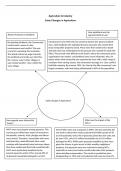Agriculture & Industry
Early Changes in Agriculture
How significant was the
Result of attacks on landlords Agrarian Reform Law?
By attacking landlords, the Communists Introduced in June 1950, this law aimed to destroy the ‘gentry-landlord’
could create a sense of class- class, with landlords who exploited the poor peasants who rented their
consciousness and conflict. This was land, having their property seized. Many were then sentenced to death
crucial for sustaining the revolution. and their land was redistributed to the peasant who worked the land (the
The attacks stirred up anger towards tiller). This proved more difficult in the South, where the communist party
the landlords and made sure that that organisation was weaker, and landlords were more influential. Also, for
the ‘enemy’ wasn’t other villages, it places where land ownership was organised by clans with a wide range of
was instead another ‘class’ within the members from varying classes, the communist message of a ‘class conflict’
same village. had little meaning. By summer 1952, the ‘land to the tiller movement’ was
largely complete, with land being redistributed to 60% of the population.
Early Changes in Agriculture
How popular were Mutual Aid What was the impact of the
Teams? APCs?
MATs were very popular among peasants. This Overall APCs were not as popular as MATs, because peasants did
was because within these teams of around ten not want to share their newly acquired land within groups of 30
households, animals, tools, ploughs and labour to 50 households. Only 14% of peasants joined the new units and
were shared. Therefore, households with more by June 1955, only 16.9 million households out of 110 million
land than they could efficiently farm could belonged to APCs. Whilst poor peasants benefited as they were
combine with households who had more labour given the chance to gain access to their wealthy neighbours’
than they needed and then both would benefit. property, rich peasants were very resistant to joining APCs,
MATs were particularly beneficial to the especially as many local cadres would undervalue their property
poorest peasants and by 1952, around 40% of when deciding compensation. The results in production were
all peasant households belonged to a MAT. disappointing: in 1953 and 54 production had risen less than 2%.




